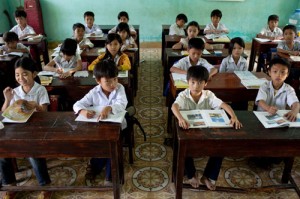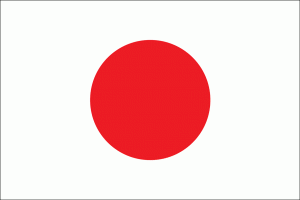 Population of Vietnam 2014
Population of Vietnam 2014
Based on the total number of births, total number of deaths, net migration rate, and the population of 2013, according to the United States Census Bureau, the population of the Socialist Republic of Vietnam for July 1, 2014 is estimated at 93,421,835, which makes up about 1.3% of the world’s total population. As of July 1, 2013, the population was estimated at 92,477,857. Thus, since last July, the population will have grown by 943,978 people or by a growth rate of about 1.02%. The last census was conducted in 2009 and it recorded the population at 85,789,573. Thus, since the last census, the population will have grown by 7,632,262 people or by an average annual growth rate of 1.78%. Based on the total land area and the total population of the country, the population density of Vietnam is 301.35 people per square kilometer or 776.34 people per square mile.
Government of Vietnam 2014
Vietnam is one of the four remaining single-party socialist states, emphasizing communism. The central and sole party in Vietnam is the Communist Party of Vietnam as established by the 1992 Constitution of Vietnam. The General Secretary of the Communist Party performs most of the administrative and executive functions of the government, which include establishing state policies, organizing the Communist Party, and making appointments. Ironically, while the country is officially a communist state, the Vietnamese economic policies have increasingly echoed capitalism in recent years. While the General Secretary performs most of the executive functions, the President of Vietnam is, by title, the head of state and the commander-in-chief of the military. He or she also serves as the Chairman of the Council of Supreme Defense and Security. The Prime Minister of Vietnam is then the head of government, serving as the executive over the various deputy prime ministers and heads of the various ministries. There are three deputy prime ministers and 26 ministries in the Vietnamese government.
The legislative body of the government is unicameral, known as the National Assembly of Vietnam. It consists of 500 members, emanating from the different parts of the country. The current Chairman of the National Assembly is Nguyen Sinh Hung, a member of the Communist Party. While the Communist Party is the sole party in the country, there are about 42 independent party members in the National Assembly. The National Assembly is the superior political body over the executive and judicial branches. The National Assembly appoints all ministers and deputies. Lastly, the highest court of appeal is the Supreme People’s Court of Vietnam. Justices serve five-year terms in the Supreme People’s Court. The current Chief Justice is Truong Hoa Binh. Lastly, as of February 2014, about 700 prison inmates are on death row.
Water Access in Vietnam 2014
In 2002, an estimated 3 million people living in the Red River Delta were considered poor. Many effects of their poverty included water-related infections and diseases, along with poor personal hygiene. In 2004, 48% of rural households in Vietnam had access to clean water, but 82% of urban households had such access. Also, only about 16% of rural households had access to water that met clean water standards. These households in rural areas were subject to using untreated water from wells and ponds and they used sanitation facilities that were poorly maintained and constructed. Thus, organizations realized that there must be some major water project conducted in order to fix these issues among the poor and rural households. The water improvement project lasted from 2005 to 2013. It gave almost 1.3 million people access to improved water sources and now 100% of poor households have access to a water supply and some form of sanitation facility. Many households also received some form of a low-interest loan in order to help them repair or replace over 48,000 hygienic toilets and sanitation facilities. As a result, instead of 25% of households with such toilets, now 87% of rural and poor households have such toilets. Over 650 public sanitation facilities were constructed for schools and health stations. Lastly, many households began to more frequently hygienically wash their hands, especially before food preparation and over 96% use some sort of soap or detergent for washing hands.
 Education in Vietnam 2014
Education in Vietnam 2014
Education in Vietnam is broken up into five levels: preschool, primary, intermediate, secondary (high school), and higher education. Students attend primary school for five years, intermediate school for four years, and secondary school for three years. Primary school typically begins at age six and is compulsory for all ages. While about the net enrollment ratio is 96%, there is a disparity of enrollment among minority ethnicities. There are five standard subjects throughout primary school: Vietnamese language, Mathematics, Morality, Arts, and Physical Education. There are a couple other subjects that the students study, based on the specific age of the student. Intermediate school typically contains some of the same subjects, but takes a deeper study of the physical sciences, such as physics and chemistry. They also study a foreign language, typically English or French, technology, and even have some vocational training courses. After completing the years in high school, the students must pass the High Graduation Examination, which is a requirement for graduation. Overall, the principle goal of education in Vietnam is to improve the general knowledge of its people, to train quality human resources, and to nurture and foster talent.
As of February 2014, the prime minister was named the chair for the national committee for education reforms. The committee looks to study and implement education and training reforms. Some potential reforms could include increasing university and training institution autonomy, investing in teacher training, and increasing partnerships between universities, training institutions, and businesses. Overall, though, the literacy and numeracy rates in the country have been quite high. As of 2012, the adult literacy rate was 93.4% and the youth male literacy rate was 97.5%, while the youth female literacy rate was 96.7%.
Vietnam Growth
Health and Health Statistics in Vietnam 2014
Vietnam has been working on improving its health care system and health insurance for all its citizens. It has implemented social care policies since 1992. But, in 2008, Vietnam passed a health insurance law that expected to grant universal health coverage to all its citizens by 2014. Health care administration is broken up into three levels throughout the country. The Ministry of Health is the main authority in the health sector, implementing policies for the whole nation. Below the Ministry of Health are 63 provincial health bureaus that operate under Provincial People’s Committees as a part of the provincial governments. Then, below the provincial level is the primary level, which consists of health centers and stations, along with the health workers.
As of 2012, the under-five mortality rate is 23 deaths per 1,000 children. The infant mortality rate is 18 deaths per 1,000 infants, while the neonatal mortality rate is 12 deaths per 1,000 babies. About 5.1% of children are born with low birth weight. About 0.4% of the population is estimated to have a positive diagnosis of HIV. Thus, about 373,687 people have been diagnosed with HIV. While there has been progress in fighting the diseases, malaria and tuberculosis are still both prominent and active diseases throughout the country. An increased sense of hygiene and an increase in vaccinations will help reduce these rates. Lastly, the overall life expectancy is 75.8 years. According to the World Health Organization in 2012, women are expected to live around 80 years, while men are only expected to live 71 years.



 Population of Spain 2014
Population of Spain 2014 Health Care in Spain 2014
Health Care in Spain 2014 Population of Japan 2014
Population of Japan 2014 Transportation in Japan
Transportation in Japan Population of Mexico 2014
Population of Mexico 2014
 Population of India 2014
Population of India 2014 Cuisine in India 2014
Cuisine in India 2014